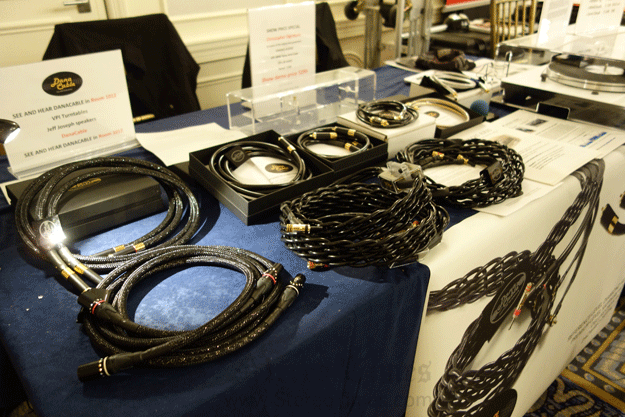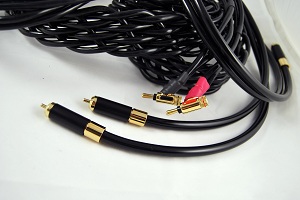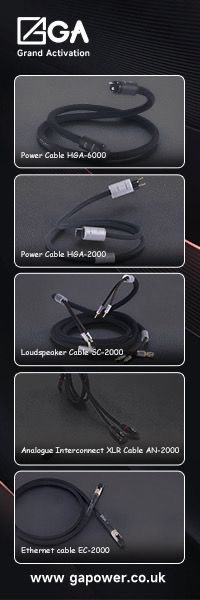Making Good Music!
Making Good Music!

 “What makes a good hi-fi cable?” has almost certainly been the most hotly discussed question in audio since we all stopped using lamp cord to connect expensive amplifiers to expensive loudspeakers (you know you did it too). Back when men’s hair was big and musicians wore spandex, I had a college roommate who returned from spring break with some new cables for which he’d paid – gasp! – two dollars a foot! That was like, forty bucks and I thought he’d lost it. You could buy a whole barrel of beer for forty bucks, and anyway we couldn’t tell the difference. Despite having a very capable Denon PMA integrated amp (which I still have and use every day in a second system), listening to the Beastie Boys’ Licensed to Ill, or the Sex Pistols, it was hard to tell where the recorded distortion ended and the system distortion took over. As long as it went up to eleven, (and who really needed that left tweeter anyway?) Rock on!!!
“What makes a good hi-fi cable?” has almost certainly been the most hotly discussed question in audio since we all stopped using lamp cord to connect expensive amplifiers to expensive loudspeakers (you know you did it too). Back when men’s hair was big and musicians wore spandex, I had a college roommate who returned from spring break with some new cables for which he’d paid – gasp! – two dollars a foot! That was like, forty bucks and I thought he’d lost it. You could buy a whole barrel of beer for forty bucks, and anyway we couldn’t tell the difference. Despite having a very capable Denon PMA integrated amp (which I still have and use every day in a second system), listening to the Beastie Boys’ Licensed to Ill, or the Sex Pistols, it was hard to tell where the recorded distortion ended and the system distortion took over. As long as it went up to eleven, (and who really needed that left tweeter anyway?) Rock on!!!
Let’s assume that in the intervening twenty-five years we’ve all grown into mature adults. OK, maybe not, but let’s at lease assume we’ve become more sophisticated about getting good sound.
This isn’t exactly news, but nowadays most audio hobbyists have accepted that cables do matter, and that the cost of cables must to be factored into a budget for building a good system. There are still a few flat-earthers who deny that cables have any impact on sound, but not many, and their dogged refusal to accept the obvious has become a marginalized position. You wouldn’t put skinny thirteen-inch steel wheels on your new Porshe because it would handle like a 1963 VW Bug. Why would you put zip cord on your new $10,000 speakers? And by the way, very similar to automobiles, the competition is fierce among cable manufacturers with many great products available to meet every need and budget.
The DanaCable Sapphire Reference interconnects and Sapphire speaker cables play hard on that competitive field, staking out a position as a neutral arbiter between components. “Neutrality” is a pretty common goal among cable makers, but somehow every manufacturer’s most neutral cable ends up sounding significantly different from the next. With so many opinions about what neutrality actually sounds like, the best advice I could give is: find a manufacturer who can offer a serious, well thought out explanation of what they’re trying to accomplish, and then see if the result sounds right to you. In the end, subjective interpretation is still going to be critical to that process. That’s a very unscientific way of testing a scientific design process, but until someone invents ears that all hear exactly the same thing that’s the best we’re going to do.
DanaCable provides a lot of solid technical information on their products on their website, but their general philosophy is that a cable “…has three electrical attributes – resistance (R), inductance (L), and capacitance (C). An ideal speaker cable would have no resistance, no inductance and no capacitance (zero R, L, and C). Not physically possible, but if it were, this cable would do no harm. The goal of DanaCable is to ‘get out of the way’ and to cause no audible effects. It allows the amplifier and speakers to do their jobs as intended.”
So DanaCable is shooting to minimize any impact on the signal. But for neutrality to be a desirable, you – as the listener – must be happy with the sound of your sources, amps, and speakers. Some people use cables to correct perceived sonic deficiencies in their electronics, which suggests they may have the wrong electronics in the first place. I’m pretty happy with my components these days, so I was looking forward to hearing whether the DanaCables imparted much signature of their own, or if I’d just hear more of what I already like about my own gear.
After giving them a lengthy break in period, the first thing I noticed wasn’t neutrality, but resolution. The Sapphire cables really bring out the little details. On Duke Ellington’s “Blues In Blueprint” from Blues in Orbit, [Columbia 1958] Harry Carney’s bass clarinet and Jimmy Wood’s bass play the introduction as a duet while drummer Jimmy Johnson snaps his fingers way off to stage left. Those ambient details became exceptionally clear: Carney’s breathing, and Wood’s fingers sliding along the strings, as well as the spaciousness of the recording studio and the slight reverberation following the finger snap. This is a remarkable recording, especially for its age. The Sapphires capture the little cues that are the difference between merely hearing a tune and actually hearing a musical performance in space.
Back to neutrality: Blues in Orbit, while a very detailed and spacious recording, also suffers a little (and just a little) from Columbia’s sonic signature of the era. The record is a little hot in the treble. I’ve heard this recording a hundred times in a dozen different systems and I think I have a pretty good handle on its general sonic attributes. The Sapphires don’t do anything to minimize or enhance those characteristics. They are, indeed, about as dead neutral on this recording as I’ve heard: the detail is remarkable, but the treble is still a little hot. That’s just what’s on the recording and it sounds about right.
The other place where neutrality is useful is comparing the sound between components, or even – in my case – components of components. My amplifier – a Cary V12r – is all tube in every sense: warm, euphonic, and a little ripe in the bass, especially running it in the lower watt triode mode. I swapped an old pair of Mullard EL84s for the Amperex version of the same tube in the input section and the differences were readily discernable. The Amperex tubes offer a much tighter and detailed image. This isn’t to say that tube changes are inaudible with other cables, but the specific qualities of various tubes were much more evident with the Sapphires.
Likewise, switching from triode (50 watts) to ultra-linear (100 watts) definitely resulted in the expected increased dynamics, bass and overall power presentation that you’d expect with a doubling of output power. In the year and half that I’ve owned it, I’ve generally preferred the low-power triode mode for it’s three dimensional presentation and warmth. There’s always been a tradeoff in the bass, but with the largely small combo jazz that makes up the bulk of my listening it hasn’t been a deal breaker. But with the Sapphires installed, switching to ultra-linear retained most of the triode mode’s finer qualities – stage depth and tone colors – with the added bonus of significantly clearer, deeper bass. It sounded better than I remembered it, in fact so well that for the first time since I acquired the amp I’m now running it in UL mode full time.
 The Tomasz Stanko New York Quartet’s Wislawa [ECM 2013] is a wonderful recording, with ECM’s signature house sound of spaciousness, detail, and ambiance. With the Cary amp Thomas Morgan’s bass is full, big and woody, but also perhaps a bit soft. David Virellas’ piano has excellent weight and presence, with the scale that a seven-foot-long resonant wooden box should, its harmonic colors rich and beautifully articulated. When he uses the sustain pedal notes, they just seem to go on forever. Stanko’s horn has his signature burnished yet airy vibrato. He sounds as good here as he ever has. Nevertheless, with the V12r driving the party through the Sapphires, no one would mistake the presentation for anything other than a tube amp. The sound has that rich, round, fullness that I’ve come to expect and love from tubes.
The Tomasz Stanko New York Quartet’s Wislawa [ECM 2013] is a wonderful recording, with ECM’s signature house sound of spaciousness, detail, and ambiance. With the Cary amp Thomas Morgan’s bass is full, big and woody, but also perhaps a bit soft. David Virellas’ piano has excellent weight and presence, with the scale that a seven-foot-long resonant wooden box should, its harmonic colors rich and beautifully articulated. When he uses the sustain pedal notes, they just seem to go on forever. Stanko’s horn has his signature burnished yet airy vibrato. He sounds as good here as he ever has. Nevertheless, with the V12r driving the party through the Sapphires, no one would mistake the presentation for anything other than a tube amp. The sound has that rich, round, fullness that I’ve come to expect and love from tubes.
Switching to the excellent Wells Audio Akasha that I had on hand, the Sapphires confirmed all of my previous impressions of this amplifier. In my review (here) I praised the Akasha’s deep, articulate bass, as well as its top-to-bottom consistency, extension, and ability to capture a good measure of the tone colors for which tubes are so beloved. The Sapphire cables reinforced my original analysis, but also provided more clarity and resolution than I’d heard in my initial review. Morgan’s bass in particular (the Akasha does bass really well) was tight, really powerful, and well resolved, while still retaining its woody texture. As with the V12, the Sapphire cables allowed the characteristics of the component to shine through.
I guess the best thing I can say about selecting an amplifier, or any other component to use with the Sapphire cables is this: pick whichever equipment you like, but make sure you really like it. You’ll know exactly what it sounds like every time you listen.
Of course, none of this answers the most important question: Do the Sapphire cables make music sound good? Well, if you’ve got a good source component, competent amplification, decent speakers, and you’re playing well-recorded material, then, yes, they sound excellent. Also, if you like what your electronics sound like, then you’ll probably appreciate the Sapphires transparency and neutrality. In my system, with either amplifier, the treble was extended and natural sounding, without any piercing sibilance unless it was on the recording. Overall they were very pleasurable to listen to.
On the other hand, they won’t flatter a lousy recording or problematic electronics. Some cables do, these don’t. If you have a lot of poorly recorded material – and there is a lot of really compelling music that is recorded badly – these might be a little too honest. Also, as I mentioned earlier, if you’re trying to fix some sonic malady in your electronics with a cable swap, the Sapphires aren’t going to be of much help. That’s what neutrality is all about. These are well made, high-quality, very revealing cables, and they admirably succeed at their design goal of getting out of the way.
A few other goodies:
 All of the DanaCable products are made from OFC copper. The Sapphire Reference interconnects are a twinaxial design with screw down locking connectors for a good snug fit. They’re very nicely finished with brass accents over their black hardware and jackets. All of the cables have a very high-quality look and feel to them and appear to have been assembled with good quality control and attention to detail.
All of the DanaCable products are made from OFC copper. The Sapphire Reference interconnects are a twinaxial design with screw down locking connectors for a good snug fit. They’re very nicely finished with brass accents over their black hardware and jackets. All of the cables have a very high-quality look and feel to them and appear to have been assembled with good quality control and attention to detail.
While the interconnects are pretty straightforward, the speaker cables are somewhat unusual. In order to allow the power signal to travel to the speaker with as little impedance as possible, DanaCable believes in deploying a lot of copper. Eight individual cables encapsulating 600 strands of wire each are woven into a belt of sorts – that’s almost 10,000 strands of wire in a pair of speaker cables. They’re huge, and very heavy. A friend suggested they could replace the suspension cables in the Brooklyn Bridge, and he might be right. No thin wimpy wires here. If you like equipment that looks and feels like you got something significant for your money, these are your speaker cables. My review pair came in a shotgun configuration with very high quality locking bananas. The bananas are stackable allowing them to be used on a single pair of terminals should you change speakers – a nice touch that came in handy when we used them on a buddy’s single-wire speakers. Despite their bulk they’re also very easy to maneuver with good flexibility. They’re really quite nice to work with.
Also, Vinh Vu, the distributor of DanaCable (through his company Gingko Audio) sent me – in addition to the Sapphire References – the standard Sapphire interconnects for comparison purposes. These are also excellent cables, a coaxial design having the same general neutrality, but with a little less ultimate resolution than the Reference version. Component matching is important, and in a more basic system, where the electronics themselves have finite resolving capabilities, the standard Sapphires would be worth looking into.
Finally, DanaCables are sold direct through Gingko Audio and come with a no-questions-asked 30-day money back guarantee, so trying them in your own system is a risk free proposition. This becomes increasingly important as hi-fi retailers continue to disappear from Main Streets all over America and more and more people buy gear online where auditioning is impossible.
To sum it up, the DanaCable Sapphire Reference interconnects and Sapphire speaker cables are well thought out, well-made cables that will let you hear what’s happening in your system with very little artifice or bias. They won’t add or subtract anything, but they won’t hide any faults either. They’ll just sound like your sources and components. If you’re looking to hear more of what your equipment really sounds like, these cables are worth auditioning. Their neutrality and resolution enhanced my system, giving me a greater appreciation of my component’s essential sonic qualities, and yes, they made really good music.


greg simmons
Specifications:
Sapphire Speaker Cables:
– 8 cable woven cables
– 9600 strand OFC copper
– locking banana termination
– 4 milliohms 2.5M run.
– 1.6 uH Inductance 2.5M run.
– 270 pF Capacitance 2.5M run.
Sapphire Reference Interconnects:
– Twinaxial design
– Locking RCA connections
– OFC copper
Sapphire Interconnects:
– Coaxial design
– Locking RCA connections
– OFC copper
Price:
Sapphire Speaker Cables, $2,950 2M pair ($500 additional .5M, $400 biwire option)
Sapphire Reference Interconnects, $900 1M RCA pair ($200 additional .5M)
Sapphire Interconnects, $600 1M RCA pair ($200 additional .5M)
Address:
Gingko Audio
8 Nicklaus Lane
Farmingdale, NJ 07727
Phone: (732) 946-9439
Fax: (732) 946-9439
E-mail: gingko@gingkoaudio.com
Website: www.gingkoaudio.com
|
Associated Equipment:
|
|||
| Analogue | |||
| SOTA Star Sapphire turntable Audioquest PT-6 arm Audio Technica OC-9 cartridge |
|||
| Digital Front End | |||
| Cambridge 840C cd player | |||
| Amplification | |||
| Emotive Audio Poeta preamplifier Cary Audio CAD-280 V12R Project Tube Box SE with NOS Mullard 12AX7 tubes |
|||
| Loudspeakers | |||
| Spendor S8e | |||
| Cabling | |||
| Zentara IC-4 Interconnects Zentara TF-8 Speaker Cables Nordost Blue Heaven interconnects LAT International SS1000Mk2 speaker cables Cullen power cords MIT Z-Cable power cords |
|||
| AC Conditioners | |||
|
Stereo Times Masthead
Publisher/Founder
Clement Perry
Editor
Dave Thomas
Senior Editors
Frank Alles, Mike Girardi, Russell Lichter, Terry London, Moreno Mitchell, Paul Szabady, Bill Wells, Mike Wright, and Stephen Yan,
Current Contributors
David Abramson, Tim Barrall, Dave Allison, Ron Cook, Lewis Dardick, John Hoffman, Dan Secula, Don Shaulis, Greg Simmons, Eric Teh, Greg Voth, Richard Willie, Ed Van Winkle, Rob Dockery, Richard Doron, and Daveed Turek
Site Management Clement Perry
Ad Designer: Martin Perry





Be the first to comment on: Making Good Music!